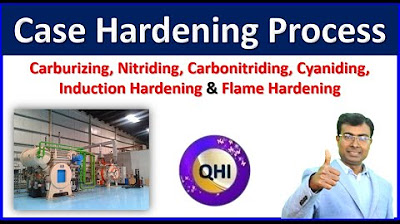cement | composition | setting and hardening | reactions involved in setting and hardening
Summary
TLDRThis video provides an in-depth explanation of cement as an essential material in engineering, focusing on its composition and the processes involved in its setting and hardening. The transcript covers the different types of cement, the chemical components, and their respective percentages. It also explains the stages of setting, which include initial setting (due to gel formation) and final hardening (through crystallization), along with the reactions that take place during these phases. The role of gypsum in cement is also discussed, highlighting its importance in enhancing the hardening process. The video concludes with insights on the timeframes for setting and hardening cement.
Takeaways
- 😀 Cement is a binding agent used in construction, made from a mixture of calcium lime, limestone, and clay material.
- 😀 There are different types of cement, such as Ordinary Portland Cement, Rapid Hardening Cement, and Sulfate Resisting Portland Cement, based on composition and application.
- 😀 Regular cement contains approximately 55-60% lime (calcium oxide), 20-25% silica, and smaller amounts of alumina, iron oxide, and other compounds.
- 😀 The process of cement setting involves mixing cement with water to form a paste that undergoes solidification through hydration reactions.
- 😀 Setting and hardening of cement occur in stages, starting with setting and followed by hardening, which strengthens the material over time.
- 😀 Initial setting occurs due to the formation of gel products from hydration, particularly from tricalcium aluminate and tetracalcium aluminoferrite.
- 😀 The formation of gel during setting helps in stiffening the original plastic mass, while hardening leads to the development of strength through crystallization.
- 😀 The hardening process of cement continues after setting and results in the formation of crystalline structures that give cement its strength.
- 😀 Gypsum is often added to cement to slow down the rapid hardening process and provide better control over setting time.
- 😀 The reactions during setting and hardening include hydration of tricalcium aluminate and gel formation from tetracalcium aluminoferrite, which contribute to the cement’s strength.
- 😀 Cement requires a curing time of around 28 days for proper setting and hardening, during which its strength increases through chemical reactions.
Q & A
What is cement and why is it called a binder?
-Cement is a binding material used in construction. It is called a binder because it holds together construction materials like bricks or stones, ensuring they harden and form a solid structure when mixed with water.
What are the different types of cement mentioned in the script?
-The different types of cement mentioned include Ordinary Portland Cement, Portland Pozzolana Cement, Rapid Hardening Cement, Sulfate Resisting Portland Cement, Blast Furnace Slag Cement, and High Alumina Cement.
What is the composition of regular cement?
-Regular cement typically consists of around 55-60% lime (calcium oxide), 20-25% silica (silicon dioxide), 7-10% alumina (aluminum oxide), 2-4% iron oxide, 2-4% magnesia, 1-2% sulfur dioxide, and about 5% alkalies such as sodium and potassium.
What is the process of setting and hardening of cement?
-The setting of cement occurs when it forms a paste after mixing with water, which stiffens over time. Hardening happens as the cement gains strength due to the formation of crystalline structures during hydration, becoming harder and stronger.
What is the difference between setting and hardening of cement?
-Setting refers to the stiffening of the cement paste as it transitions from a plastic form to a solid state. Hardening, on the other hand, refers to the development of strength in the cement over time due to crystallization.
What are the reactions involved during the setting of cement?
-During the setting of cement, reactions like hydration of tri-calcium aluminate (C3A) and gel formation from tetra-calcium aluminoferrite (C4AF) occur, leading to the formation of a stiffened mass.
What is the role of gypsum in cement?
-Gypsum is added to cement to control the rate of setting. When mixed with water, it reacts with tri-calcium aluminate to form an insoluble compound, helping in the formation of a hard mass, which facilitates proper hardening.
What happens during the hydration reaction of tri-calcium aluminate?
-When water is added to tri-calcium aluminate (C3A), a reaction occurs that releases energy and forms calcium hydroxide (Ca(OH)2), contributing to the heat generation during the early stages of setting.
What is the significance of the gel formation from tetra-calcium aluminoferrite?
-The gel formation from tetra-calcium aluminoferrite (C4AF) contributes to the initial setting of the cement. This reaction, along with the hydration of other compounds, leads to the stiffening and early strength gain in the cement.
How long does it take for cement to set and harden fully?
-Cement typically requires about 28 days to fully set and harden. In the first few days, the initial setting occurs, followed by final setting and hardening, during which the cement develops its strength.
Outlines

This section is available to paid users only. Please upgrade to access this part.
Upgrade NowMindmap

This section is available to paid users only. Please upgrade to access this part.
Upgrade NowKeywords

This section is available to paid users only. Please upgrade to access this part.
Upgrade NowHighlights

This section is available to paid users only. Please upgrade to access this part.
Upgrade NowTranscripts

This section is available to paid users only. Please upgrade to access this part.
Upgrade NowBrowse More Related Video

Surface hardness || Hardening || Heat treatment

What is Certificate of Inspection? It's functions, Types and Benefits of certificate of inspection?

Case Hardening and 6 Types of Case Hardening || Heat Treatment Process

Cimentos de Ionômero de Vidro - Composição, Indicações e Reação de Presa

Princípios de Biópsia

Techniques for Solving Energy Problem | Procedure for Solving Material Balance Problem | PE Chemical
5.0 / 5 (0 votes)